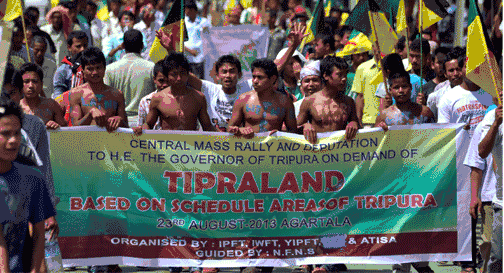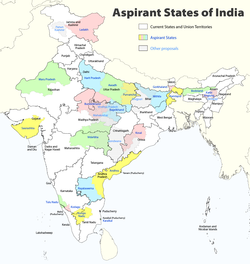Tipraland
Tipraland is the name of a proposed state in India for the Tripuri people who inhabit the Tripura Tribal Areas.

Background
The formation of "Tipraland", a state within the Tripura Tribal Areas, under articles 2 and 3 of the Indian Constitution is demanded by a political party called the Indigenous People's Front of Tripura (IPFT) as one of their political agenda.[1] Another registered regional political party Tipraland State Party (TSP) also demanding the same demand of Tipraland. The Kingdom of Tripura is a former country which was ruled by 184 Tripuri/Tipra kings.[2] The first king of the Manikya Dynasty of Tripura was Maha Manikya, who ruled the kingdom in the early 15th century.[3] The earlier kings are partly mythological and partly legendary or semi-legendary. The second last king was Maharaja Bir Bikram Kishore Debbarman Manikya Bahadur. After his death in 1947, Tipra kingdom joined India as a C-Model State on 15 October 1949 under the name Tripura, and later achieved statehood on 21 January 1972.[4]
Tripura Tribal Areas Autonomous District Council
The indigenous Tipra people demanded an autonomous district council, which they finally achieved on 23 March 1979 which is known as Tripura Tribal Areas Autonomous District Council (TTAADC).[5] The politically important TTAADC constitutes two-thirds of Tripura's 10,491 km2 area, which has 12,16,465 (mostly tribals) of the state's 37 lakh population residing in it.[6] Tribal Welfare Department (Government of Tripura) strictly monitoring the implementation of the Tripura Scheduled Castes and Scheduled Tribes Reservation Act, 1991 (As amended up to February, 2006) for departmental promotion / direct recruitment in all Government Departments / PSUs and local bodies. For admission in schools / colleges, allotment of seats in Medical / Engineering and other Technical and General Courses, 31% reservation for ST is strictly followed.[7] Schedule Tribes in Tripura are exempted from income tax.[8]
Demographics
Historically, the Kirati Tripuri converted Hindu rulers of Tripura's Manikya dynasty had always encouraged the immigration of and settlement of non-tribals, especially Bengalis to Tripura. The Rajmala authenticates the fact that Ratna Manikya (1462-1487) was the first to ‘settle 4000 Bengalis in four places’ in Tripura.[9] During Noakhali riots in 1946 many Bengali Hindu survivors referred to as East Bengali Refugees were sheltered in temporary relief camps in Comilla, Chandpur, Agartala the present capital of Tripura and other places. A large migration of Bengali Hindus and Muslims took place in Assam, Meghalaya, Tripura and other places during Bangladesh Liberation War on 1971.[10]
| Year | Tota; | 137,937 | 166,500 | 54.67 | 45.31 |
|---|---|---|---|---|---|
| 1931 | 382,450 | 179,123 | 203,327 | 53.16 | 46.84 |
| 1941 | 513,010 | 256,019 | 256,991 | 50.09 | 49.91 |
| 1951 | 639,029 | 401,071 | 237,958 | 37.23 | 62.77 |
| 1961 | 1,142,005 | 781,935 | 360,070 | 31.53 |
References
- "Indigenous People's Front Of Tripura (IPFT) | The North East Today | Delivering news up to the minute". thenortheasttoday.com. Retrieved 16 July 2017.
- "History TTAADC | TTAADC". ttaadc.gov.in. Retrieved 16 July 2017.
- Momin, Mignonette; Mawlong, Cecile A.; Qādrī, Fuz̤ail Aḥmad (2006). Society and economy in North-East India. New Delhi: Regency Publications. p. 81. ISBN 978-81-87498-83-4.
- "Historical Background | Tripura State Portal". tripura.gov.in. Retrieved 16 July 2017.
- "About TTAADC | TTAADC". ttaadc.gov.in. Retrieved 16 July 2017.
- "TRIPURAINFO : The first news, views & information website of TRIPURA". www.tripurainfo.com. Retrieved 16 July 2017.
- "Reservation Policy | Department of Welfare for Scheduled Tribes". twd.tripura.gov.in. Retrieved 16 July 2017.
- "Tax Exemption Only For STs Living In NE States". The Financial Express. Retrieved 16 July 2017.
- Ghoshal, Anindita. "Changing Mentality of the Bengali Refugees: The Story of Tripura (1946-1971)". Cite journal requires
|journal=(help) - "Over 11 lakh Bangla nationals entered NE during 1971-83 - Silchar". Silchar. 19 March 2017. Retrieved 16 July 2017.
- Ghoshal, Anindita. "Changing Mentality of the Bengali Refugees: The Story of Tripura (1946-1971)". Cite journal requires
|journal=(help)
